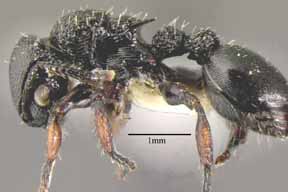

Formicidae, Hymenoptera, Insecta, Arthropoda, Animalia
|
|
|
Image catalogue, neotype worker (click here).
Line drawing from Kempf 1964 (click here).
Range
Bolivia, Brazil, Colombia, Guyana, Panama, Paraguay, Peru, Trinidad, Venezuela.
Description of worker
Neotype worker measurements: HW 1.130, HL 1.085, SL 0.715, EL 0.294, MeL 1.242, MeW 0.830, PrW 0.603, PrL 0.297, PrS 0.180, PrT 0.477, MTL 0.721, PtL 0.408, PtW 0.393, PpW 0.505, PtH 0.388, AL 1.219, AW 1.087, ASW 0.022.
Face to vertex margin with evenly dispersed discrete foveae, distance between foveae subequal to fovea diameter; interspaces with silky sheen and faint areolate etchings; clypeus abruptly bent ventrad, with a median longitudinal carina and a few longitudinal carinulae near lateral margins, otherwise smooth with microareolate sculpture; frontal carina thickened just posterior to torulus, ending on dorsum of torulus; genae closely foveate; genal bridge longitudinally rugose; mandible longitudinally striate; in anterior view, eyes asymmetrically convex, skewed ventrad; scape with flange over condyle and neck, flattened over entire length, narrow basally, broadening distally; surface of scape finely areolate, outer lateral margin shallowly punctatorugose; vertex margin angulate but not crenate; vertex shiny with variable extent of longitudinal striae radiating from occiput.
Mesonotal lobes small, forming right-angles or subacute teeth; propodeal lobes in the form of a broadly convex anterolateral margin that tapers toward propodeal teeth, or with posterolateral tooth delimiting posterior border; promesonotum foveate anteriorly, grading into variable mix of foveae and longitudinal striae posteriorly; dorsal face of propodeum longitudinally striate; propodeal suture impressed, in profile forming a distinct v-shaped notch; posterior face of propodeum perpendicular to dorsal face, completely smooth and shining; dorsal face of pronotum meets flat lateral face at rounded angle; lateral face of pronotum, anepisternum, katepisternum, and lateral face of propodeum longitudinally striate; forecoxae smooth or striate; hind femur strongly swollen medially, spindle-shaped; outer surfaces of tibiae punctatorugose; posterior face of forefemur smooth and shining.
Petiole short, anterior face with coarse transverse striae, posterior face rugose-foveate, ventral margin flat with small anterior tooth; postpetiolar dorsum evenly convex, longitudinally rugose; ventral margin short, with a prominent, acute anterior tooth; first gastral tergite finely longitudinally striate, striae superimposed on micropunctate sculpture (giving granular appearance), striae becoming somewhat irregular in center of disc, formed from irregular rows of small puncta; first gastral sternite with bands of subparallel longitudinal striae along lateral margins, remainder smooth and shiny with sparse piligerous puncta; second gastral tergite with micropunctate granular sculpture.
Dorsal surfaces with sparse, stiff setae, about 10 on face, 30 on promesonotum, 10 on dorsal face of propodeum, 10 on petiole, 15 on postpetiole, 30 on first gastral tergite; these setae about 0.12mm long, longer on petiole and postpetiole; first gastral sternite with sparse suberect hairs, finer and more flexuous than dorsal setae; color black, usually with lighter red brown to orange tibiae.
Description of queen:
Queen measurements (n=1, Brazil, barcode LACM ENT 141637): HW 1.242, HL 1.186, SL 0.765, EL 0.375, MeL 1.719, MeW 1.022, MTL 0.858, MFL 0.940, MFW 0.324, PtL 0.502, PtW 0.439, PpW 0.588, PtH 0.455, AL 1.548, AW 1.205, ASW 0.025.
Similar to worker in most respects; pronotum, mesoscutum, axillae, and scutellum foveate; interspaces subequal to or greater than fovea diameter, with microareolate sculpture; foveae on mesoscutum distinctly elongate; dorsal face of propodeum irregularly rugose-foveate.
Comments:
Procryptocerus hylaeus is a South American species that barely makes it into Central America. Only one Central American specimen is known, from a canopy fogging sample from near Gatun Lake, Panama. It is very similar to and broadly sympatric with the South American species P. goeldii.
Natural History
This species inhabits wet or moist forest canopy. Collections are most often from canopy fogging samples, treefalls, or photo-eclectors. The species is abundant in J. Adis' canopy ant samples from near Manaus. A P. S. Ward collection from Bolivia was from a nest in a dead twig.
Types and Synonymy
Procryptocerus goeldii Forel (part): Forel, 1912:207 (Santa Marta worker identified as P. goeldii).
Procryptocerus goeldii subsp. hylaeus Kempf, 1951:50-51. Holotype worker: Colombia, Naranjo, foot of Sierra Nevada de Santa Marta (Forel). Neotype worker: Brazil, Amazonas: Ilha de Curari, Várzea [3°15'S, 59°49'W], 22.i.1976, ex ground photo-eclector (J. Adis) [LACM]. Barcode: LACM ENT 141647.
Procryptocerus hylaeus: Kempf, 1964b:247, Fig. 5 (raised to species). Longino and Snelling 2002 (designation of neotype).
Page author:
John T. Longino, The Evergreen State College, Olympia WA 98505 USA. longinoj@evergreen.edu
Date of this version: 6 December 2002.